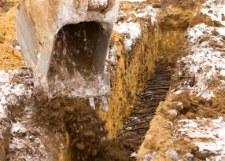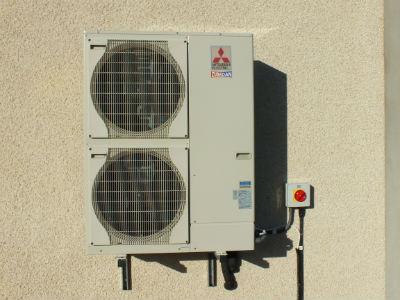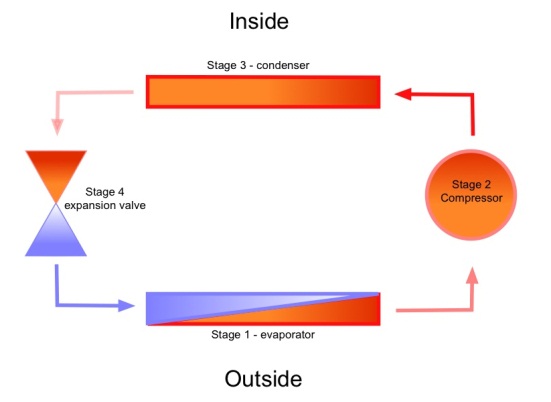- Home
- What are Heat Pumps
- Ground Source Heat Pumps
What is a Ground Source
Heat Pump?
A ground source heat pump (often referred to as a geo thermal heat pump) is probably one of the more stable sources of heat as the ground temperature doesn't fluctuate as much as air or water temperature does.
The simple explanation for this type of heat pump is they draw heat from the ground and transfer it into your home via your heating system. You can get more detailed information on the workings of heat pumps in my article on how heat pumps work.
There are two types of ground source heat pump:
- The closed
loop system (or horizontal loop system).
- The bore hole system.

They both take advantage of the fact that in the UK at 1.2m - 1.5m below the surface of your garden the ground is at a fairly constant temperature of between 5 and 15 degrees Celsius depending on the time of year.
This provides a constant source of energy which can be transferred into heat for your home.
Closed Loop System:
This involves digging large trenches, approximately 1-1.5m deep (to get below the frost line) in the area around your house (but only if you own it) and laying "U-shaped" or "slinky shaped" pipe-work in the bottom of the trench.
The U-shaped
pipe-work option (most efficient option) involves laying straight
sections of pipe-work connected at the ends of the trench with U-shaped
sections (this system avoids the pipes lying on top of each other as in
the slinky style system). To help you visualise think of the under-floor heating pipes inside your home as these are laid in a U shaped method also.
The U-shaped installation does however require larger trenches than the slinky method as the pipes need to be around 75cm apart.
A typical U-shaped pipe installation for an average 3 bed detached house in the UK, requiring approx. 10.5 Kilowatts of heating energy would require approximately 3 trenches containing 115-180 meters of pipe in each trench.
The longer the loop of pipe-work the more heat you can get. Therefore larger houses will require longer lengths.
The cost of digging a trench tends to be around half the cost of drilling a borehole, which is why if you have the room for a trench it is normally your best/cheapest option.
An efficient ground source heat pump will produce water at around 35 - 45 degrees Celsius which is ideal for under-floor heating.
However, if you have normal radiators which require around 65 deg. C. you'll either have to:
- Make the system work harder (which will use more electricity) and therefore cost more.
- Put up with cooler than normal radiators (they will still heat your home).
- Or change your radiators to large panel radiators which operate at a lower temperature.
Efficiency table:
| Replaced fuel | Ground Source of typical efficiency | Ground Source of Good efficiency |
|---|---|---|
| Gas | £40 more expensive | £70 saving |
| Oil | £50 saving | £160 saving |
| Solid Fuel | £260 saving | £370 saving |
| Electric heating | £420 saving | £530 saving |
The figures above will vary depending on how efficient your old boiler was. Some old boilers can be as low as 50% efficient (or less), but modern condensing boilers are typically around 90% efficient.
Comare this to 250% - 300% efficient for a ground source heat pump (i.e. each kW of energy used to power heat pump can produce up to 3Kw of energy from the ground i.e 300% efficient).
Cost of Installing a Ground Source Heat Pump:
Typical installation costs in the UK are around £6,000 - £15,000 depending on the size of your house and your family’s demands for hot water. These costs include replacing your existing hot water cylinder as you will need a new twin coil cylinder with a large surface area coil to transfer the heat to your domestic hot water.
If you're also going to use solar thermal panels you may want to install an even larger cylinder as you'll need a third coil. One for the boiler (if you have one as a backup), one for the heat pump and one for the solar panels.
As a comparison it is currently unlikely to be cost effective to replace an efficient mains gas boiler with a ground source heat pump.
If this is the case you could consider an air source heat pump which is cheaper and may be more cost effective for your situation.
Vertical Boreholes:
These will suit smaller sites where you don't have enough space to use a horizontal system. The down side is it will cost more to drill a bore hole (typically around twice the price of digging trenches).
As an example of what is required, the house mentioned above would require around three bore holes to a depth of around 90-110m.
Once the bore holes are drilled a pipe loop is lowered into the bore hole and then a grout is used to fill the hole and help with heat transfer.
A ground source heat pump system does have advantages and disadvantages which you can read about by following this link.
As you can see, installing a ground source heat pump can be a significant investment but once it's installed (assuming it is running efficiently) you should have lower running costs.
Your electricity costs will likely increase but you won't have to pay for oil or gas etc. so overall you should see lower bills.
As ground source heat pumps need electricity, photovoltaic panels make an ideal companion as they allow you to produce your own electricity on site which you can then use to power your heat pump whether it is ground source or air source.










New! Comments
Have your say about what you just read! Leave me a comment in the box below.